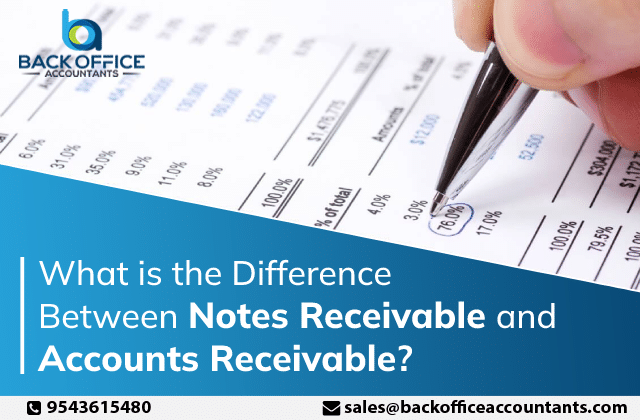Maintaining liquidity is the most important aspect of running a successful business. So far in our blogs here at backofficeaccountants.com, our accounting experts have only dealt with Accounts Receivable as of the lifeblood of revenue and liquidity which is true. But there are other types of receivables like Notes Receivable which is issued under different circumstances, serve a different purpose but are equally crucial to maintain the liquid position and working capital for the company.
But what is notes receivable and what is the difference between accounts receivable and notes receivable? What are the features of notes receivable and what role do they play in helping and business improve its cash position? All these questions are answered with inputs from our accounting experts at Back Office Accountants here. Read on:
What is Notes Receivable?
Notes receivable is a formal promissory note that is issued to a payee by the issuer. It is a legally written document that clearly states the principal amount, date of issuance, maturity date, and interest to be paid along with the names of the issuer and payee.
The notes receivable is an asset whose category depends on the term of issuance. It is classified as a current asset if the note receivable is issued for less than a year. In case it is used for a longer period, the portion of the amount that is received within that year is classified as a current asset and the rest is classified as a non-current asset. Also, notes receivable are transferable i.e. its ownership can be transferred and the new bearer shall have the claim to note post the ownership transfer.
Characteristics of Notes Receivable:
Here the principal amount is the amount burrowed by the payee from the issuer. The maturity date is the date when the payee must pay the ending balance of the note. The term is the period from the date of issuance to the date of maturity. As the note receivable is interest-bearing, the payee is bound to pay the interest as per the annual interest rate mentioned in the notes receivable. So the ending note balance here is the principal amount plus the interest calculated through the maturity date.
An Example for Notes Receivable:
Let us take an example for a better understanding. Let us assume company A is the customer of company B that makes a purchase worth $500,000 and need an extended amount of time for repayment. Upon the request from company A, B makes assents to accept notes receivable with an interest of 10% and a term of 24 months.
Company B now makes its journal entry $500,000 under Notes Receivable. The interest accrued at the year’s end is recorded in the journal and upon payment of the ending note balance, company B will again journal the collection. In case company A dishonours the respective Notes Receivable, B converts it into Accounts Receivable.
Difference between Accounts Receivable and Notes Receivable:
Both Accounts Receivable and Notes Receivable are financial statement line items that are categorized as current assets. But both serve quite different purposes, issues under different circumstances and are dealt differently.
Unlike Accounts Receivable which is an informal agreement between the payee (buyer) and the company (seller) that is resolved in a short time, notes receivable is a legal contract with the interest component.
A note receivable is commonly requested in exchange for the goods bought or money (lending) and tends to stretch beyond one operating cycle. The amount in case of notes receivable is much higher than receivable, it stretches longer as a result of the interest component.
Benefits of Notes Receivable:
Notes receivable are viewed as a representation of strength and having them, in general, is seen as favourable standing. Being a long term asset, notes receivable will benefit a business far beyond the current fiscal year. It can also be utilized as collateral payment for a different business transaction or to satisfy any other financial obligations.
Given accounts receivable and notes receivable as assets are distinct from each other both can be leveraged by a business to further shorten the cash collection period, improve cash flow, enhance the asset potential and even attract a more diverse clientele. However, many businesses still do not fully utilize the power of effective Accounts Receivable management to improve their cash position.
If you are a business that is looking to improve your working capital and liquidity and overall cash position you need expert help that can help you lay a solid foundation and help manage your Accounts Receivable. As a leading remote accounting firm in the market equipped with a team of expert accountants, Back Office Accountants can help you in this regard. You can contact us here: https://www.backofficeaccountants.com/








